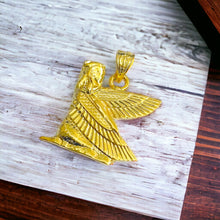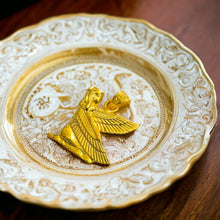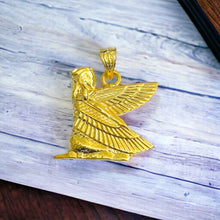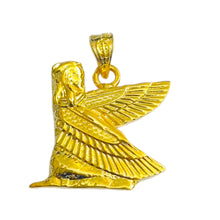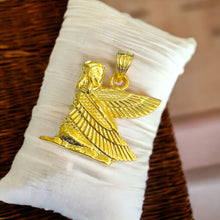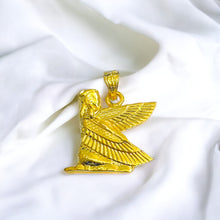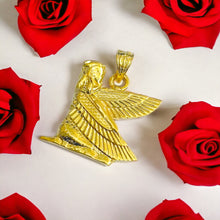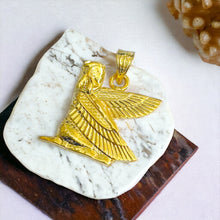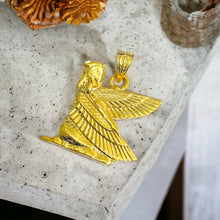
The Goddess Isis Gold Pendant Necklace is a stunning piece of jewelry inspired by the ancient Egyptian goddess Isis, known for her symbolism of healing, protection, and magic. Historically, Isis was one of the most important deities in Egyptian mythology, often depicted with outstretched wings. This necklace typically features a gold pendant with intricate detailing, reflecting the timeless elegance and spiritual significance associated with the goddess. The design embodies a blend of ancient artistry and modern craftsmanship, making it a cherished accessory for those who appreciate historical and cultural heritage.
- History: Inspired by ancient Egyptian mythology, symbolizing femininity, power, and magic.
- Spiritually: Represents Goddess Isis, associated with motherhood, healing, and protection.
- Talisman: Believed to bring strength, wisdom, and blessings to the wearer.
- Handmade: Crafted with care, each piece unique, showcasing intricate craftsmanship.
- Healing: Thought to promote emotional balance and spiritual growth.
- Material: Made from genuine gold and brass, blending luxury with durability.
- Symbolism: Depicts wings of Isis, symbolizing protection and guidance.
- How to Wear: Fits any chain up to 5mm, versatile for various styles and occasions.
History Side For Those Who Are Interested
Isis, one of the most important deities of ancient Egyptian religion, was revered as the goddess of magic, motherhood, and fertility. Her worship began in the Predynastic Period (c. 6000-3150 BCE) and extended into the Greco-Roman era, lasting until the rise of Christianity in the late antiquity period. Her significance and attributes evolved over millennia, reflecting the changes in Egyptian society and religious practices.
Isis is first mentioned in the Pyramid Texts of the Old Kingdom (c. 2686-2181 BCE), where she is depicted as a mourner for her murdered husband, Osiris, and as the mother of Horus. In these texts, she is portrayed as a powerful and magical healer who brings Osiris back to life and aids in the rebirth of the deceased king. This role established her as a goddess of life, death, and rebirth.
Central to Isis's mythology is her association with Osiris, her husband, and Horus, her son. According to the myth, Osiris was killed by his jealous brother Set, who dismembered his body and scattered the pieces across Egypt. Isis, with her magical abilities, gathered the pieces and resurrected Osiris, who then became the god of the underworld. She also conceived Horus, who later avenged his father and restored order to Egypt. This myth underscored Isis's role as a devoted wife and mother, as well as her power over life and death.
Isis was often depicted as a woman wearing a throne-shaped crown, symbolizing her association with the pharaoh and the throne of Egypt. She is also shown with a solar disk and cow's horns, linking her to Hathor, another prominent goddess. In many representations, she is depicted nursing the infant Horus, emphasizing her role as a nurturing mother. The ankh, a symbol of life, and the tyet, known as the "knot of Isis," are also frequently associated with her.
The worship of Isis was widespread throughout Egypt, with major temples dedicated to her at Philae, Abydos, and Behbeit el-Hagar. Her cult was characterized by elaborate rituals and festivals, including the "Isis Navigium," a festival celebrating her role in navigation and protection of sailors. The priestesses of Isis, who played significant roles in her temples, were often regarded as powerful healers and magicians.
During the Ptolemaic period (323-30 BCE), the worship of Isis expanded beyond Egypt, spreading throughout the Mediterranean world. The Greeks and Romans adopted her into their own pantheons, often merging her attributes with those of their own goddesses, such as Demeter and Aphrodite. Temples dedicated to Isis were established as far afield as Rome, Pompeii, and London. The spread of her cult was facilitated by the cosmopolitan nature of the Hellenistic world and the Roman Empire.
The worship of Isis continued well into the Roman period but began to decline with the rise of Christianity. By the end of the 4th century CE, her temples were closed, and her cult was suppressed by the Christian authorities. However, her influence persisted, and many of her attributes were assimilated into Christian iconography, particularly in the depiction of the Virgin Mary.
In modern times, Isis remains a symbol of the enduring power of ancient Egyptian culture and religion. She continues to be a subject of interest in contemporary spirituality and popular culture, reflecting her timeless appeal and the lasting impact of her mythology.













